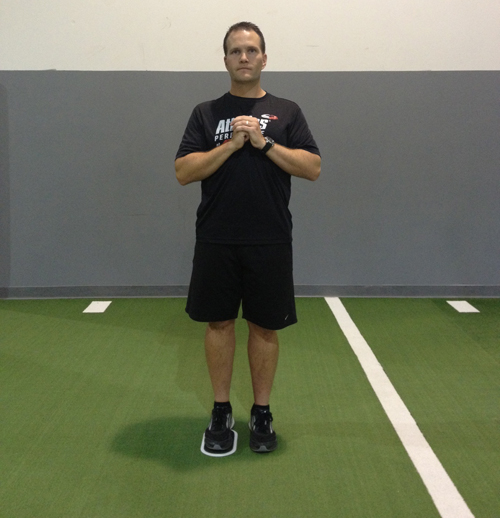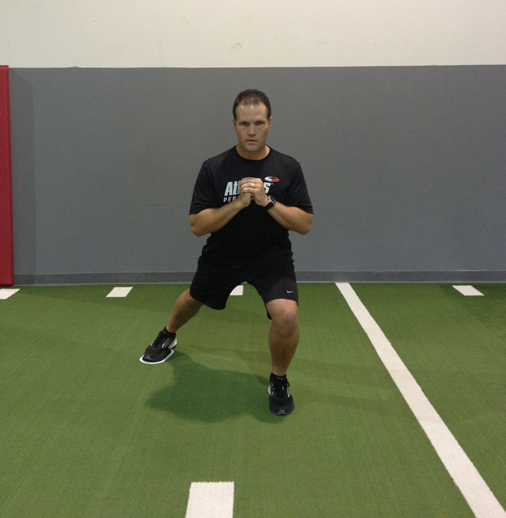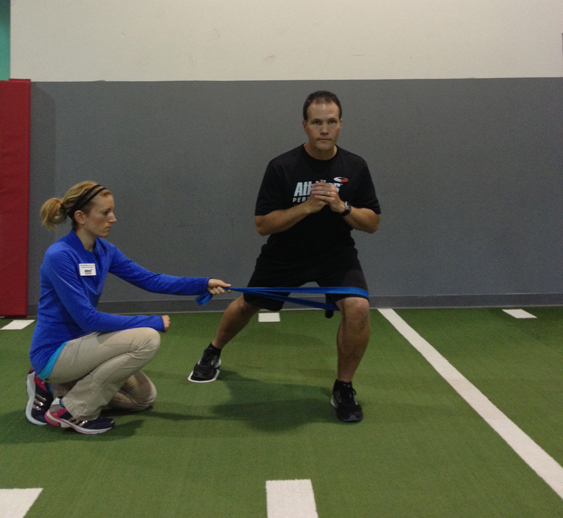
All effective prehab and rehab programs for athletes should build in single leg stability exercises. I like to use sliding exercises as one way to improve neuromuscular control of the core, hip and knee. This exercise will demonstrate an effective way using (sliders/gliding discs) to improve strength and closed kinetic chain alignment.
Execution:
Begin standing with the feet together and the left foot on a slider. Clasp the hands together or fold one on top of another while keeping the arms in and close to the body. Slowly slide the left foot in a posteromedial direction (45 degree angle back and away from the stance leg) while maintaining proper knee alignment of the right leg (knee pointing in line with the second toe).
Pause at the bottom and then return to the starting position. Perform 2 sets of 10-15 reps on each side. Focus on keeping the trunk still throughout the movement to keep the emphasis on the stance leg.
Progression:
Add external resistance in the form of a light theraband or tubing to further pull the stance leg into a valgus/internally rotated position. This will enhance activation of the hip external rotators and further challenge stability of the hip and knee. Note: do not pull too forcefully, but just enough to cue the desired muscle activation pattern.
Application:
This exercise is effective in injury prevention and rehab programs for those with ankle instability or past sprains, anterior knee pain, hip weakness, poor landing mechanics and higher ACL risk if playing pivoting and cutting sports. It will improve core stability, hip and knee strength/stability, dynamic balance, groin flexibility and trunk control.
A slower cadence on the eccentric portion of the exercise is preferable to maximize stability and strength gains. However, do not force through any painful ranges of motion. Proper control and alignment outweighs depth and exercise volume as layering a poor neuromuscular pattern will only further perpetuate altered motor control and dysfunction.
Brian Schiff, PT, OCS, CSCS, is a licensed physical therapist, respected author and fitness professional. Currently, he serves as the supervisor for Athletes' Performance at Raleigh Orthopaedic in Raleigh, NC. Brian conducts live continuing education webinars and presents nationally at professional conferences and seminars on injury prevention, rehab and sport-specific training. For more information on his products and services, visit www.BrianSchiff.com.
Execution:
Begin standing with the feet together and the left foot on a slider. Clasp the hands together or fold one on top of another while keeping the arms in and close to the body. Slowly slide the left foot in a posteromedial direction (45 degree angle back and away from the stance leg) while maintaining proper knee alignment of the right leg (knee pointing in line with the second toe).
Pause at the bottom and then return to the starting position. Perform 2 sets of 10-15 reps on each side. Focus on keeping the trunk still throughout the movement to keep the emphasis on the stance leg.
 |  |  |
Progression:
Add external resistance in the form of a light theraband or tubing to further pull the stance leg into a valgus/internally rotated position. This will enhance activation of the hip external rotators and further challenge stability of the hip and knee. Note: do not pull too forcefully, but just enough to cue the desired muscle activation pattern.
Application:
This exercise is effective in injury prevention and rehab programs for those with ankle instability or past sprains, anterior knee pain, hip weakness, poor landing mechanics and higher ACL risk if playing pivoting and cutting sports. It will improve core stability, hip and knee strength/stability, dynamic balance, groin flexibility and trunk control.
A slower cadence on the eccentric portion of the exercise is preferable to maximize stability and strength gains. However, do not force through any painful ranges of motion. Proper control and alignment outweighs depth and exercise volume as layering a poor neuromuscular pattern will only further perpetuate altered motor control and dysfunction.
Brian Schiff, PT, OCS, CSCS, is a licensed physical therapist, respected author and fitness professional. Currently, he serves as the supervisor for Athletes' Performance at Raleigh Orthopaedic in Raleigh, NC. Brian conducts live continuing education webinars and presents nationally at professional conferences and seminars on injury prevention, rehab and sport-specific training. For more information on his products and services, visit www.BrianSchiff.com.
















